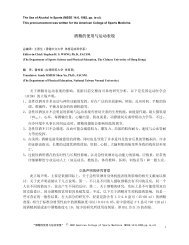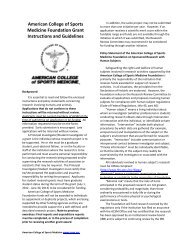Plyometric Training - American College of Sports Medicine
Plyometric Training - American College of Sports Medicine
Plyometric Training - American College of Sports Medicine
You also want an ePaper? Increase the reach of your titles
YUMPU automatically turns print PDFs into web optimized ePapers that Google loves.
ACSM CURRENT COMMENT<br />
<strong>Plyometric</strong> <strong>Training</strong> for Children and Adolescents<br />
Children and adolescents need to participate regularly in physical activities that enhance<br />
and maintain cardiovascular and musculoskeletal health. While boys and girls have<br />
traditionally been encouraged to participate in aerobic training and strength building<br />
activities, a growing number <strong>of</strong> children and adolescents are experiencing the benefits <strong>of</strong><br />
plyometric training. <strong>Plyometric</strong>s refer to exercises that link strength with speed <strong>of</strong> movement<br />
to produce power and were first known simply as “jump training.”<br />
Previously thought <strong>of</strong> as a method <strong>of</strong> conditioning reserved for adult athletes, the <strong>American</strong><br />
<strong>College</strong> <strong>of</strong> <strong>Sports</strong> <strong>Medicine</strong> (ACSM) contends that plyometric training is a safe, beneficial<br />
and fun activity for children and adolescents provided that the program is properly designed<br />
and supervised.<br />
<strong>Plyometric</strong> training conditions the body through dynamic, resistance exercises. This type <strong>of</strong><br />
training typically includes hops and jumps that exploit the muscles’ cycle <strong>of</strong> lengthening and<br />
shortening to increase muscle power. <strong>Plyometric</strong> exercises start with a rapid stretch <strong>of</strong> a<br />
muscle (eccentric phase) and are followed by a rapid shortening <strong>of</strong> the same muscle<br />
(concentric phase). With plyometric training, the nervous system is conditioned to react<br />
more quickly to the stretch-shortening cycle. This type <strong>of</strong> training enhances a child’s ability<br />
to increase speed <strong>of</strong> movement and improve power production. Regular participation in a<br />
plyometric training program may also help to strengthen bone and facilitate weight control.<br />
Further, plyometric training performed during the preseason may decrease the risk <strong>of</strong><br />
sports-related injuries. This may be <strong>of</strong> particular benefit to young female athletes who<br />
appear to be at increased risk for knee injuries as compared to young male athletes.<br />
There are thousands <strong>of</strong> plyometric exercises, ranging from low intensity double leg hops to<br />
high intensity drills such as depth jumps. Although the latter is typically associated with<br />
plyometric training for the mature athlete, common games and activities such as hopscotch,<br />
jumping rope and jumping jacks can also be characterized as plyometrics because every<br />
time the feet make contact with the ground the quadriceps are subjected to the stretchshortening<br />
cycle. In fact, plyometrics are a natural part <strong>of</strong> most movements, as evidenced by<br />
the jumping, hopping and skipping seen on any school playground. With qualified coaching<br />
and age-appropriate instruction, plyometric training can be a safe, effective and fun method<br />
<strong>of</strong> conditioning for children and teenagers. However, there is the potential for injury to occur<br />
if the intensity and volume <strong>of</strong> the training program exceeds the abilities <strong>of</strong> the participants.<br />
Children and adolescents should develop an adequate baseline <strong>of</strong> strength before<br />
participating in a plyometric training program, or they should simply begin plyometric training<br />
with lower intensity drills and gradually progress to higher intensity drills over time. Although<br />
additional clinical trials are needed to determine the most effective plyometric training<br />
program for children and adolescents, beginning with one to three sets <strong>of</strong> six to 10<br />
repetitions on one upper body exercise (e.g., medicine ball chest pass with a one-kilogram<br />
ball) and one lower body exercise (e.g. double leg hop) twice per week on nonconsecutive<br />
days seems reasonable. If multiple sets are performed, participants must be provided with<br />
adequate rest and recovery between sets (e.g., two to four minutes) in order to replenish the<br />
energy necessary to perform the next series <strong>of</strong> repetitions with the same intensity.<br />
Unlike traditional strength training exercises, plyometric exercises are performed quickly and<br />
explosively. <strong>Plyometric</strong> exercises may be introduced into the warm-up period or<br />
incorporated into group game activities. Depending upon individual needs and goals, the<br />
plyometric training program can progress to include multiple jumps, single leg hops and<br />
throws using lightweight medicine balls. Modifying the program over time will help to<br />
optimize gains and prevent overtraining.
ACSM CURRENT COMMENT<br />
Children and adolescents should be provided with specific information on proper exercise<br />
technique, rate <strong>of</strong> progression and safe training procedures (e.g., warm-up and cool-down).<br />
Also, children and adolescents must wear supportive athletic footwear and plyometric<br />
exercises should be performed on surfaces with some resilience. <strong>Plyometric</strong>s are not<br />
intended to be a stand-alone exercise program and should be incorporated into a welldesigned<br />
overall conditioning program that also includes strength, aerobic, flexibility, and<br />
agility training.<br />
<strong>Plyometric</strong> training may not only make children and adolescents faster and more powerful;<br />
this type <strong>of</strong> training may <strong>of</strong>fer observable health benefit to young populations. The<br />
contention that plyometrics are inappropriate for boys and girls is not consistent with the<br />
needs <strong>of</strong> children and teenagers or their physical abilities. <strong>Plyometric</strong> training is a safe,<br />
worthwhile and fun method <strong>of</strong> conditioning for children and adolescents if age-appropriate<br />
guidelines are followed, qualified instruction is available, and individual concerns are<br />
addressed.<br />
Written for the <strong>American</strong> <strong>College</strong> <strong>of</strong> <strong>Sports</strong> <strong>Medicine</strong> by Avery D. Faigenbaum, Ed.D.and<br />
Donald A. Chu, Ph.D., PT, ATC<br />
Current Comments are <strong>of</strong>ficial statements by the <strong>American</strong> <strong>College</strong> <strong>of</strong><br />
<strong>Sports</strong> <strong>Medicine</strong> concerning topics <strong>of</strong> interest to the public at large.<br />
Street Address: 401 W. Michigan St. • Indianapolis, IN 46202-3233 USA<br />
Mailing Address: P.O. Box 1440 • Indianapolis, IN 46206-1440 USA<br />
Telephone: (317) 637-9200 • FAX: (317) 634-7817
















